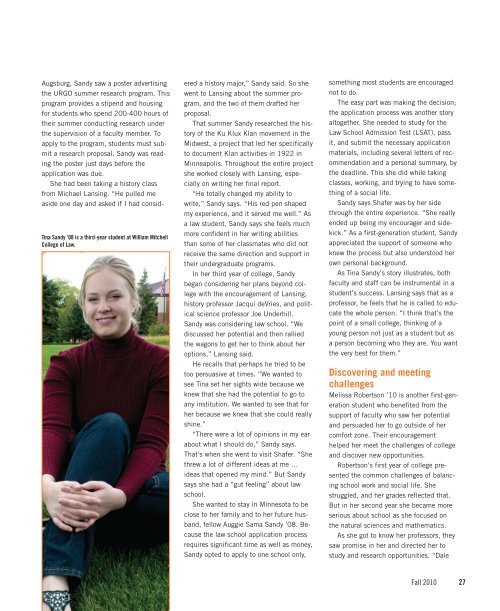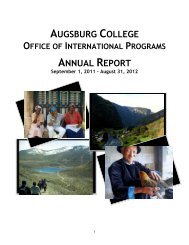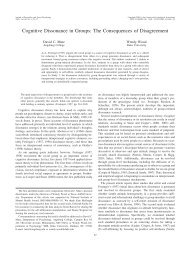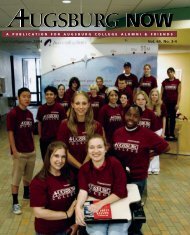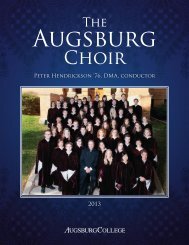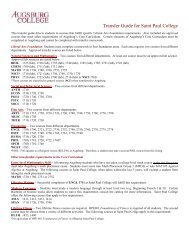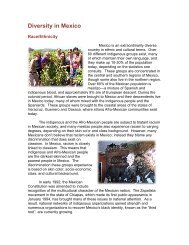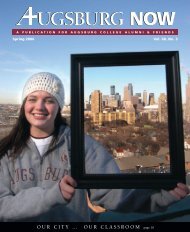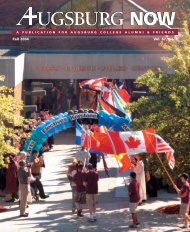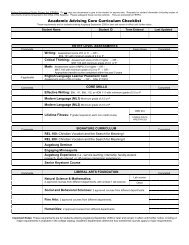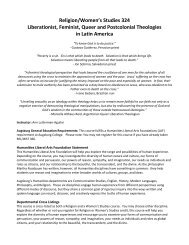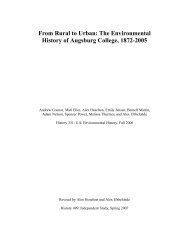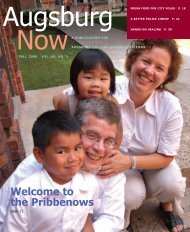this PDF for more - Augsburg College
this PDF for more - Augsburg College
this PDF for more - Augsburg College
- No tags were found...
You also want an ePaper? Increase the reach of your titles
YUMPU automatically turns print PDFs into web optimized ePapers that Google loves.
Tina Sandy ’ 08 is a third-year student at William Mitchell<strong>College</strong> of Law.<strong>Augsburg</strong>, Sandy saw a poster advertisingthe URGO summer research program. Thisprogram provides a stipend and housing<strong>for</strong> students who spend 200-400 hours oftheir summer conducting research underthe supervision of a faculty member. Toapply to the program, students must submita research proposal. Sandy was readingthe poster just days be<strong>for</strong>e theapplication was due.She had been taking a history classfrom Michael Lansing. “He pulled measide one day and asked if I had considereda history major,” Sandy said. So shewent to Lansing about the summer program,and the two of them drafted herproposal.That summer Sandy researched the historyof the Ku Klux Klan movement in theMidwest, a project that led her specificallyto document Klan activities in 1922 inMinneapolis. Throughout the entire projectshe worked closely with Lansing, especiallyon writing her final report.“He totally changed my ability towrite,” Sandy says. “His red pen shapedmy experience, and it served me well.” Asa law student, Sandy says she feels much<strong>more</strong> confident in her writing abilitiesthan some of her classmates who did notreceive the same direction and support intheir undergraduate programs.In her third year of college, Sandybegan considering her plans beyond collegewith the encouragement of Lansing,history professor Jacqui deVries, and politicalscience professor Joe Underhill.Sandy was considering law school. “Wediscussed her potential and then ralliedthe wagons to get her to think about heroptions,” Lansing said.He recalls that perhaps he tried to betoo persuasive at times. “We wanted tosee Tina set her sights wide because weknew that she had the potential to go toany institution. We wanted to see that <strong>for</strong>her because we knew that she could reallyshine.”“There were a lot of opinions in my earabout what I should do,” Sandy says.That’s when she went to visit Shafer. “Shethrew a lot of different ideas at me …ideas that opened my mind.” But Sandysays she had a “gut feeling” about lawschool.She wanted to stay in Minnesota to beclose to her family and to her future husband,fellow Auggie Sama Sandy ’08. Becausethe law school application processrequires significant time as well as money,Sandy opted to apply to one school only,something most students are encouragednot to do.The easy part was making the decision;the application process was another storyaltogether. She needed to study <strong>for</strong> theLaw School Admission Test (LSAT), passit, and submit the necessary applicationmaterials, including several letters of recommendationand a personal summary, bythe deadline. This she did while takingclasses, working, and trying to have somethingof a social life.Sandy says Shafer was by her sidethrough the entire experience. “She reallyended up being my encourager and sidekick.”As a first-generation student, Sandyappreciated the support of someone whoknew the process but also understood herown personal background.As Tina Sandy’s story illustrates, bothfaculty and staff can be instrumental in astudent’s success. Lansing says that as aprofessor, he feels that he is called to educatethe whole person. “I think that’s thepoint of a small college, thinking of ayoung person not just as a student but asa person becoming who they are. You wantthe very best <strong>for</strong> them.”Discovering and meetingchallengesMelissa Robertson ’10 is another first-generationstudent who benefited from thesupport of faculty who saw her potentialand persuaded her to go outside of hercom<strong>for</strong>t zone. Their encouragementhelped her meet the challenges of collegeand discover new opportunities.Robertson’s first year of college presentedthe common challenges of balancingschool work and social life. Shestruggled, and her grades reflected that.But in her second year she became <strong>more</strong>serious about school as she focused onthe natural sciences and mathematics.As she got to know her professors, theysaw promise in her and directed her tostudy and research opportunities. “DaleFall 201027


